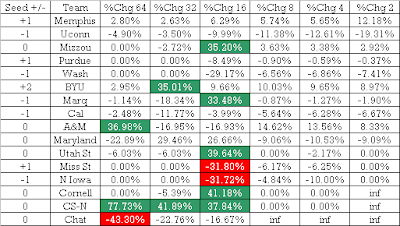Vegas already touched on this today, but the 6-line is incredibly tough this year. UCLA, WVU, Arizona State, and Marquette most likely represent the toughest 6-line the committee has ever put together, at least from a pythagorean perspective. Those 6-seeds - particularly UCLA, WVU, and ASU - absolutely destroy the probabilities of their respective twos and threes making it to Detroit.
To illustrate how strong the sixes are, I re-seeded each of the regions by Pomeroy pyth and simulated how the tournament would play out, along with calculating the change in probability from the real bracket to this simulated one. The results are below.
Midwest:


West:


South:


East:


I had really hoped to show that teams that were underseeded saw their probabilities for winning go up if properly seeded, and vice versa. What I really showed was how important it was that UCLA, WVU, and ASU were underseeded. Those teams that are unlucky enough to face those three early on see their win probabilties sky rocket when moved away. Likewise, teams that would be matched up with the sixes would see their win probabilities fall if the committee used Pomeroy for developing the S-Curve.
What does it all mean? Seeding is important, obviously. However, if the committee significant underseeds or overseeds a team, it can have drastic effects down the bracket for other schools' chances of cutting down the nets.




0 comments:
Post a Comment